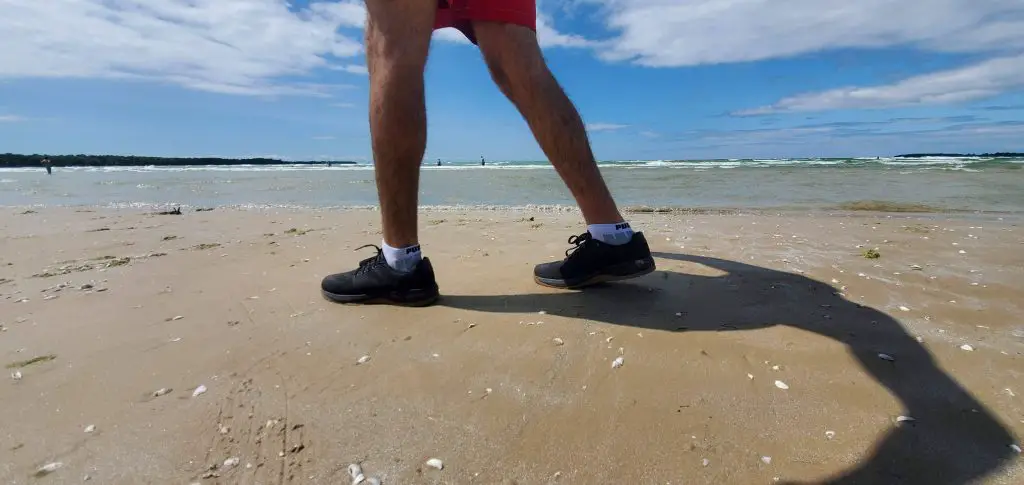
Rucking in the sand, such as at the beach or in the desert, poses a whole new set of challenges. Sand is firm-packed but soft enough that it will shift under your feet as you apply weight to it. How do you prep for rucking on sand if there are no beaches around?
Here’s how to train to ruck in the sand:
1- Ruck or run barefoot in the grass
2- Try to train on the beach before your ruck
3- Strengthen your calves outside of rucking
In this article, we’ll get straight to the point and provide you lots of actionable tips and tricks for rucking on the beach and on sand. We’ll even talk about the benefits of rucking this way, so let’s get started!
How to Prepare for Rucking in Sand
Ruck or Run Barefoot in the Grass
In some parts of the country, beaches are plentiful, while in others, they’re few and far between. To replicate the unpredictability of sand without a beach, try rucking in the grass. Here’s a twist: do it shoeless. You can also run if that’s preferable, but again, ditch the shoes.
Why? According to Verywell Fit, you can boost your efficiency by as much as four percent when you run barefoot. Although skipping shoes certainly takes some getting used to, doing so can strengthen the muscles not only in your feet, but also your legs, ankles, and even your hips.
This can improve your coordination and your balance, helping you to achieve a feeling of being grounded that’s a must when you’re running in sand. The sensory experience is great too, especially if you’re running early in the morning through dewy grass!
Train on the Beach Before Your Ruck
At least once, you want to get out there on the sand and practice your rucking technique. Perhaps you arrive at the site of the ruck event a day early and ruck on that beach/desert or in an area nearby.
As much as strengthening your legs and feet by running barefoot on grass can help, nothing beats the real deal!
Strengthen Your Calves Outside of Rucking
Once you get out there on the sand, you’ll realize how much more resistance you’re dealing with when rucking than you do when on the hard road. Running alone can’t train your body for the rigors that are to come.
When you’re at the gym, focus on working your calves and legs. Try doing some standing barbell calf raises, seated calf raises, box jumps, jumping jacks, single-leg calf raises, and seated band pushes to get your legs in rucking shape! Here’s some other rucking exercises if you’re looking to take things to the next level!
The Benefits of Rucking on the Beach
Once you get used to rucking in the sand, going back to doing so on hard concrete or asphalt might not be as appealing anymore. Here are several benefits to a good beach ruck!
1- Peaceful Surroundings
Rucking is grueling, and although your surroundings usually aren’t pretty, the exception is certainly the beach. The call of the gulls, the cool sea breeze, the sound of the waves crashing, and the pliability of the sand under your feet; this adds up to a unique rucking experience!
2- Better Core Stability
Since sand is difficult to balance on, once you find your footing and can maintain it, you build stability in your core. This is a nice bonus core workout that you usually don’t get when rucking on flat, hard, even surfaces.
3- Less Impact on Joints
The softness of sand means that for every step you take, you’re putting less impact on your joints and your bones. This might allow you to ruck for longer without pain. You can also go rucking shoeless in the sand if you truly wanted to without worrying about joint aches.
If you’re still looking for more reasons to ruck, here’s a complete list of rucking benefits!
My Final Thoughts on Rucking on Sand
Rucking on the beach could be the new challenge you’ve been looking for. As the sand moves beneath your feet, you’ll need to use your core for stabilization and have strong leg, hip, and feet muscles to handle the new terrain.
Personally, I’ve tried it in the past but had my shoes on most of the time. It definitely was a challenge for me and could only go for half the time I’m used to when rucking on pavement. I am certainly not against it though, because I really do believe that if I kept it going, I’d be able to take things to the next level.


